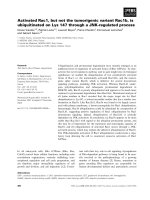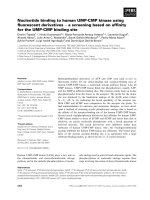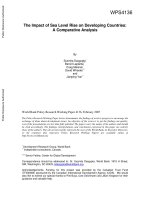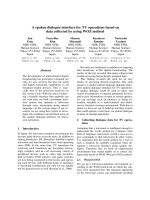The IRS Receivables Balance Is Based on Data Maintained for Collection Purpoeee_part1 pdf
Bạn đang xem bản rút gọn của tài liệu. Xem và tải ngay bản đầy đủ của tài liệu tại đây (768.02 KB, 11 trang )
I_ “I l_.l” ll l_“l *_(-
_l-” _. _ _ ”
GAO
IRS Significantly
Overstated Its
Accounts Receivable
Balance
___ I “” “_
l_-l l.l ” ____ _I_._ -
__ __. - . . . _-II
-_
( ;A( WA k’hl
lb-!):3-4
2
This is trial version
www.adultpdf.com
_“^l _ _ “ _ _ __ ._ ____- __. _-_-__
This is trial version
www.adultpdf.com
Accounting and Financial
Management Division
B-262330
May 6,1993
Mr. Michael P. Dolan
Acting Commissioner
Internal Revenue Service
Dear Mr. Dolan:
This report presents the results of our review of accounts receivable at the Internal Revenue
Service (~8). We conducted this review as part of our financial statement audit of IRS pursuant
to the Chief Financial Officers Act of 1990 (Public Law 101-576).
This report contains recommendations to you. As you know, the head of a federal agency is
required by 31 USC. 720 to submit a written statement on actions taken on these
recommendations. You should send the statement to the Senate Committee on Governmental
Affairs and the House Committee on Government Operations within 60 days of the date of this
letter and to the House and Senate Committees on Appropriations with the agency’s first
request for appropriations made over 60 days after the date of this letter.
We are sending copies of this report to the Chairmen and Ranking Minority Members of the
Senate Committee on Governmental Affairs; the Senate Committee on Finance; the House
Committee on Government Operations; the House Committee on Ways and Means; the
Subcommittee on Commerce, Consumer and Monetary Affairs, House Committee on
Government Operations; the Subcommittee on Oversight, House Committee on Ways and
Means; the Joint Committee on Taxation; the Secretary of the Treasury; the Director of the
Office of Management and Budget; and other interested parties. Copies will be made available
to others upon request.
This report was prepared under the direction of Jeffrey C. Steinhoff, Director, Civil Audits, who
may be reached at (202) 512-9454 if you or your staff have any questions. Other major
contributors are listed in appendix II.
Sincerely yours,
Donald H. Chapin
Assistant Comptroller General
This is trial version
www.adultpdf.com
Executive Summary
Purpose
The Internal Revenue Service’s (IRS) reported gross accounts receivable
have increased from $16.8 bi)lion in 1980 to $110.7 billion as of
September 30,199l. This large balance implies that the American
taxpayers owe a tremendous amount ln unpaid federal taxes, and some
have cited this figure as a potential source of government revenue.
Primarily because of the high reported growth rate of IRS receivables, this
issue has been designated by
GAO
and the Office of Management and
Budget a high-risk area in the federal government, targeted for special
management attention.
GAO
reviewed the validity and collectibility of
IRS
reported accounts
receivable as of June 30,1991, in preparation for its audit of the IRS fiscal
year 1992 financial statements. In accordance with authority granted by
the Chief Financial Officers (CFO) Act of 1990,
GAO
elected to perform this
audit.
Background
IRS, as part of the Department of the Treasury, is the nation’s largest
revenue collector. It is responsible for both routine tax collection and
pursuing delinquent tax payments. For fiscal year 1991,
IRS
reported
collections of about $1.1 trillion. Although most federal taxes are paid
either before or at the time taxpayers file their returns, some are not.
Unpaid assessments occur when (1) a tax return is filed without full
payment, (2) an employer falls to deposit payroll taxes, (3) an audit
identifies additional amounts owed, or (4) an estimated assessment is
recorded for a nonfiler. Outstanding assessments are the basis for
IRS
reported accounts receivable.
In prior testimonies and reports,
GAO
questioned the reliability of
IRS’
reported accounts receivable balance.
GAO
reported
IRS’
estimate of gross
receivables of about $111 billion and
IRS’
estimated collectible receivables
of about $30 billion as of September 30,lQQl. To complete its audit of
IRS’
first set of financial statements,
GAO
performed extensive tests as of
June 30, 1991, to allow it to reliably estimate the accounts receivable
balance and the amount of this balance that was collectible.
GAO
analyzed
the
IRS
reported receivables by examining a random sample of 1,646 tax
assessments that were outstanding as of June 30,1991, the most recent
data available at the time
GAO’S
sample was drawn.
GAO
also evaluated
IRS
new methodology for estimating the collectibility of its receivables, which
IRS first applied in its September 30,19Ql, report to Treasury.
Page 2
GAO/AFMD.93-42 IRS Receivables
This is trial version
www.adultpdf.com
Esacuth Summary
Results in Brief
GAO’S
analysis showed that the IRS reported gross receivables balance for
June 30,1991, was overstated by as much as $39.4 billion and that about
two-thirds of what was owed was not likely to be collected. Because the
composition of IRS gross receivables changed little during the 3 subsequent
months,
GAO
believes that the overstatement is also reflected in the IRS
September 30,1991, balance, The following table compares the projected
results of
GAO’S
analysis with
IRS
reported balances for June and
September 1991.
Table 1: Comparlson of GAO’s
Analysis Wlth the IRS Reported
Balances.
Dollars in billions
GAO’s analysis IRS reported IRS reported
of IRS 6’30/91
balance as of balance as of
balance
6/30/91
9130191
IRS gross reported receivables
$104.7
Invalid receivables (39.4)
Subtotal
65.3
$104.7
b
104.7
$107.0
b
107.0
Uncollectible (46.6)
(38.4)
(78.6)
Net collectible receivables
$ 18.7c
$66.4O
$ 28.4c
aAll three sets of figures are for the IRS two largest account files, which cover about 96 percent of
the IRS total gross reported receivables.
bNot
computed.
CA significant portion of the net collectible receivables Is not currently collectible because it is
attributable to deferred estate taxes and installment payments.
IRS
overstated its gross receivables primarily because it included duplicate
and insufficiently supported assessments that it had recorded as part of its
efforts to identify and collect taxes due. These and many erroneous
assessments were not valid receivables for financial reporting purposes
and should
not
have been included in the reported balances.
l
In addition,
IRS
estimates regarding the collectibility of its receivables were
unreliable. Its June estimate did not involve any substantive analysis of
collectibility, and the methodology used to develop its
September estimate, while involving a more extensive analysis, was also
flawed. In addition to including invalid receivables in its
September analysis,
IRS
relied solely on collection experience and did not
group assessments according to their collection risk nor consider the
taxpayers’ current ability to pay.
Page 3
GAO/AFMD-9342 IRS Receivables
This is trial version
www.adultpdf.com
IRK figures have been used in congressional deliberations regarding the
impact increased collections could have on reducing the deficit, assessing
receivables growth, evaluating IRS enforcement and collection
performance, and making decisions regarding IRS staffing needs. Further,
some taxpayers may perceive that Ins efforts to collect taxes are not
equitable based on the disparity between IRS gross receivables and
amounts expected to be collected. This, in turn, could affect vohmtary
compliance with the tax laws. Also, GAO’s estimate that most of the IRS
valid receivables are not likely to be collected is a reflection, in part, of the
IRS cumbersome collection process, as previously reported by GAO. More
reliable information on receivables could allow IRS to more effectively
allocate resources, determine staffing levels, and measure enforcement
and collection performance.
Principal Findings
IRS Overstated Its Gross
Receivables
Based on GAO’S analysis, IRS gross receivables balance as of June 30,1991,
was overstated by as much as $39.4 billion because it was based on data
maintained by a system that had been developed to support IRS
enforcement and collection efforts rather than financial reporting and
other financial management needs. IRS systems were not designed to
distinguish between assessments that represent valid receivables and
those that do not. As a result, IRS reported balances included (1) multiple
assessments against individuals made in an attempt to collect a business’
tax liability and (2) estimated assessments against nonfilers based on
limited data. In addition, many assessments were erroneous, due to IRS and
taxpayer errors.
The lack of complete and accurate data on
IRS
receivables hinders its
ability to develop the best collection strategies, put resources to their best
use, and measure its performance. Also, high error rates and inefficient
systems create additional work for both IRS and taxpayers. Further, the
inaccurate information provided Members of Congress and the public with
an exaggerated idea of the potential for increasing collections to reduce
the deficit.
IRS
has several accounting system improvement projects under way that, if
successfully completed, will reduce erroneous assessments and improve
system efficiency. However, as currently planned, these efforts are not
Page 4
GAOAFMD-9342 IRS Receivables
This is trial version
www.adultpdf.com
Executive Summary
intended to provide IRS the capability to readily identify the assessments
that should be included as receivables in its financial reports. Also, these
efforts continue to be conducted under the Assistant Commissioner for
Returns Processing, whose primary responsibility is processing tax
returns, an operating responsibility. Although the IRS CFO is responsible for
financial management, the CFCI does not have the authority to ensure that
IRS systems provide needed data.
IRS Methodology for
Reliably estimating an allowance for uncollectible receivables requires
Estimating Collectibility Is
consideration of both historical collection experience and current
Not Reliable
economic conditions since collectibility may change as economic
conditions change. Also, according to a standard recently recommended
by the Federal Accounting Standards Advisory Board, such an analysis
should be performed on groups of accounts with similar collection risk
characteristics and should include an evaluation of individual accounts to
determine the taxpayers’ current ability to pay.
IRS acknowledged that, prior to its September 30,1991, report to Treasury,
it did not have a meaningful methodology for estimating the uncollectible
portion of its receivables balance. The methodology that
IRS
first applied in
its September 30,1991, report to Treasury, while representing an extensive
analysis of receivables, was also flawed. In addition to basing its
assessment on its overstated gross receivables balance, IRS did not analyze
individual taxpayer accounts to determine the taxpayers’ current ability to
pay. Further, although
IRS
developed historical collection rates for groups
of assessments, the assessments within these groups did not have similar
collection risk characteristics, and
IRS
did not consider current and
forecast economic conditions.
Recommendations
GAO
recommends that the Commissioner of the Internal Revenue Service
provide the
IRS
Chief Financial Officer authority to ensure that the
IRS
accounting system development efforts meet its financial reporting and
other financial management needs. At a minimum, the Chief F’inancial
Officer’s approval of related system designs should be required. In
addition,
GAO
recommends that the Commissioner direct the Chief
Financial Officer to
. develop a strategy for distinguishing between assessments that should be
included in the receivables balance and those that should not and include
Page 5
GAWAFMD-BB-42 IRS Receivables
This is trial version
www.adultpdf.com
Executive Summary
only valid receivables in the balances reported in
IRS
financial statements,
and
l
modify
IRS
methodology for assessing the collectibility of its receivables by
(1) including an analysis of individual taxpayer accounts to assess their
ability to pay and (2) basing group analyses on (a) categories of
assessments with similar collection risk characteristics, (b) current and
forecast economic conditions, and (c) historical collection data
Agency Comments
In its response,
IRS
took no exception to
GAO’S
findings and supported the
recommendations.
IRS
stated that it is moving forward to place
responsibility for the entire revenue accounting function under the Chief
F’inancial Officer. Also,
IRS
stated that it has made significant strides in
evaluating its assessments and in excluding certain assessments from its
accounts receivable. Further,
IRS
said that it is conducting a statistical
study of its accounts receivable in order to determine their collectibility.
GAO
plans to evaluate the effectiveness of these efforts as part of its
ongoing audit of the
IRS
financial statements. The
IRS
comments are
discussed and evaluated in chapters 2 and 3 and are included in
appendix I.
Page 6
GAO/AFMD-98-42 IRS Receivables
This is trial version
www.adultpdf.com
a
Page 7 GAO/AFMD-93-42 IRS Receivables
This is trial version
www.adultpdf.com
Contents
Executive Summary
Chapter 1
Introduction
Background
Objectives, Scope, and Methodology
10
10
13
Chapter 2
The IRS Receivables
Balance Is Based on
Receivables Balance Included Assessments That Did Not
Represent Valid Receivables
Lack of Emphasis on Financial Reporting and Inadequate
16
16
20
Data Maintained for
Collection Purposes
Systems Have Affected Report Accuracy
Improvement Efforts Continue to Neglect Financial Reporting
Conclusions
Recommendations
Agency Comments and Our Evaluation
22
26
26
27
Chapter 3
IRS Methodology for
Estimating
Collectibiky Is Not
Reliable
Estimating Collectibility Requires Both Analysis of Individual
Accounts and Groups and Consideration of Historic, Current, and
Forecast Data
IRS Analysis Included Invalid Receivables and Did Not Consider
Taxpayers’ Current Ability to Pay
28
29
IRS’ Collection Process Diminishes Accounts’ Collectibility
30
33
Conclusions
34
Recommendations
35
Agency Comments and Our Evaluation
35
Appendixes
Tables
Appendix I: Comments From the Internal Revenue Service
36
Appendix II: Major Contributors to This Report
39
~-
Table 1: Comparison of GAO’s Analysis With the IRS Reported
3
Balances
Table 1.1: Number and Dollar Value of Tax Assessments as of
June 30,199l
12
Figures
Figure 1.1: IRS Year-End Accounts Receivable Balances for Fiscal
Years 1980 Through 1991
Figure 2.1: Reasons Sampled Assessments Did Not Represent
Valid Receivables
17
a
Page 8
GAO/AFMD-93-42 IRS Receivables
This is trial version
www.adultpdf.com
Contenta
Figure 3.1: Comparison of the IRS and GAO Estimates on the
Collectibility of IRS Receivables as of September 1991 and
June 1991, Respectively
29
Figure 3.2: Reasons Receivables in Our Sample Were
Uncollectible
33
Abbreviations
BMF
CFO
FAASAB
ITD
GAO
IMF
IRS
OMI3
business master tile
Chief Financial Officer
Federal Accounting Standards Advisory Board
Federal Tax Deposit
General Accounting Office
individual master file
Internal Revenue Service
Office of Management and Budget
Page 9
CAOAFMD-93-42 IRS Receivables
This is trial version
www.adultpdf.com









